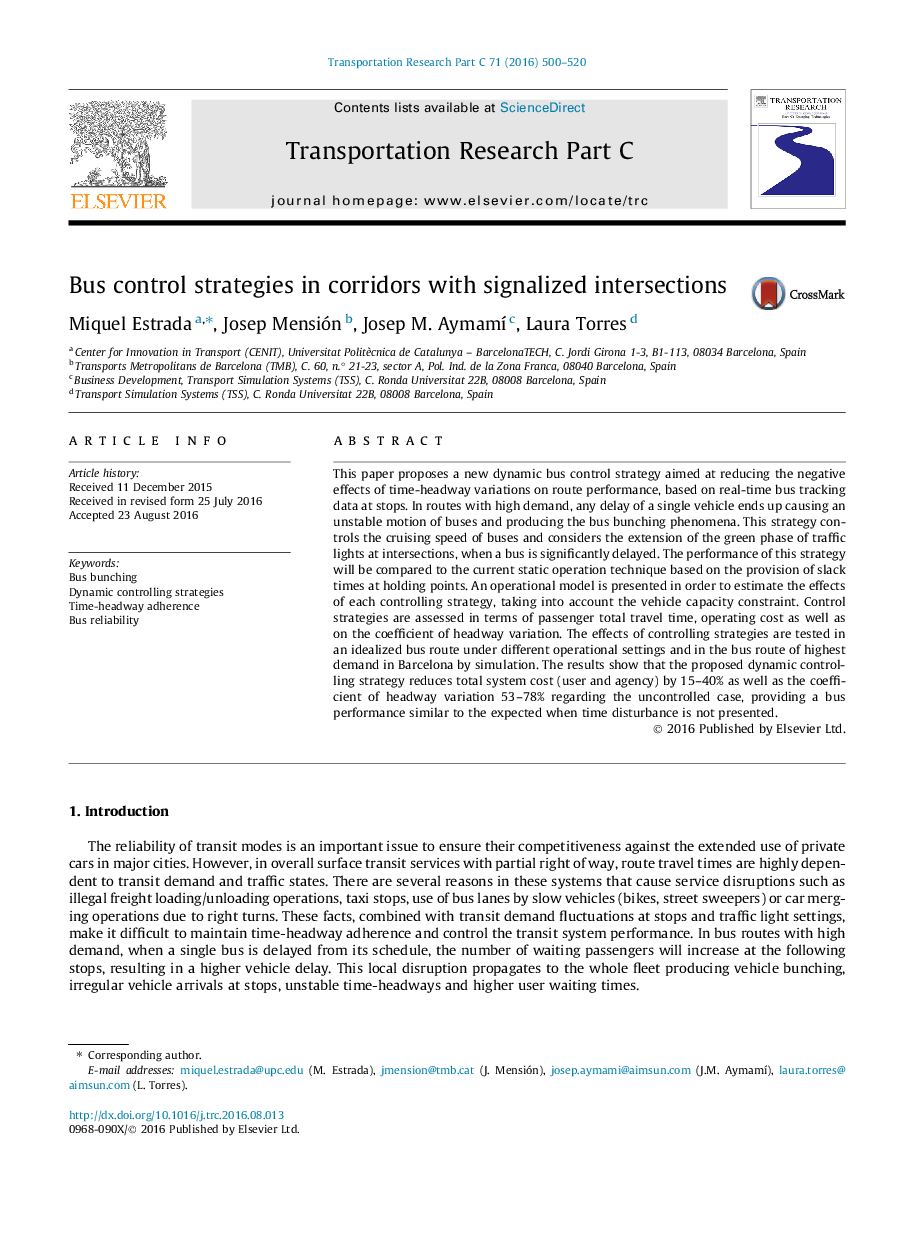| کد مقاله | کد نشریه | سال انتشار | مقاله انگلیسی | نسخه تمام متن |
|---|---|---|---|---|
| 6936337 | 869081 | 2016 | 21 صفحه PDF | دانلود رایگان |
عنوان انگلیسی مقاله ISI
Bus control strategies in corridors with signalized intersections
ترجمه فارسی عنوان
استراتژی کنترل اتوبوس در راهرو ها با تقاطع های سیگنال
دانلود مقاله + سفارش ترجمه
دانلود مقاله ISI انگلیسی
رایگان برای ایرانیان
کلمات کلیدی
دسته بندی اتوبوس، استراتژی های کنترل پویا، پیروی از زمان، قابلیت اطمینان اتوبوس،
ترجمه چکیده
در این مقاله، یک استراتژی کنترل پویا جدید با هدف کاهش اثرات منفی تغییرات زمان بندی در عملکرد مسیر، بر اساس داده های ردیابی در زمان واقعی در ایستگاه ها ارائه می شود. در مسیرهایی با تقاضای زیاد، هر تأخیری از یک وسیله نقلیه به پایان می رسد و موجب حرکت بی نظیر اتوبوس ها و تولید پدیده های دسته بندی اتوبوس می شود. این استراتژی، سرعت گذر اتوبوس ها را کنترل می کند و گسترش فاز سبز چراغ های راهنمایی در تقاطعات را بررسی می کند، زمانی که یک اتوبوس به طور قابل توجهی به تأخیر می افتد. عملکرد این استراتژی با روش فعلی عملیات استاتیک بر اساس زمان بارگیری در نقاط نگهداری مقایسه می شود. یک مدل عملیاتی برای برآورد اثرات هر استراتژی کنترل، با توجه به محدودیت ظرفیت وسایل نقلیه ارائه شده است. استراتژی های کنترل از لحاظ زمان سفر کل مسافر، هزینه عملیاتی و همچنین ضریب تغییر مسیر پیشرفت می شود. اثرات استراتژی های کنترل در یک مسیر اتوبوس ایده آل شده در شرایط عملیاتی مختلف و در مسیر اتوبوس با بیشترین تقاضا در بارسلونا با شبیه سازی آزمایش می شود. نتایج نشان می دهد که استراتژی کنترل پویا پیشنهادی هزینه کل سیستم (کاربر و آژانس) را به میزان 15-40٪ کاهش می دهد و همچنین ضریب تغییرات پیشرفت 53-78٪ در مورد مورد غیرقابل کنترل است و عملکرد شبیه به زمان مورد انتظار را انتظار می رود اختلال ارائه نشده است.
موضوعات مرتبط
مهندسی و علوم پایه
مهندسی کامپیوتر
نرم افزارهای علوم کامپیوتر
چکیده انگلیسی
This paper proposes a new dynamic bus control strategy aimed at reducing the negative effects of time-headway variations on route performance, based on real-time bus tracking data at stops. In routes with high demand, any delay of a single vehicle ends up causing an unstable motion of buses and producing the bus bunching phenomena. This strategy controls the cruising speed of buses and considers the extension of the green phase of traffic lights at intersections, when a bus is significantly delayed. The performance of this strategy will be compared to the current static operation technique based on the provision of slack times at holding points. An operational model is presented in order to estimate the effects of each controlling strategy, taking into account the vehicle capacity constraint. Control strategies are assessed in terms of passenger total travel time, operating cost as well as on the coefficient of headway variation. The effects of controlling strategies are tested in an idealized bus route under different operational settings and in the bus route of highest demand in Barcelona by simulation. The results show that the proposed dynamic controlling strategy reduces total system cost (user and agency) by 15-40% as well as the coefficient of headway variation 53-78% regarding the uncontrolled case, providing a bus performance similar to the expected when time disturbance is not presented.
ناشر
Database: Elsevier - ScienceDirect (ساینس دایرکت)
Journal: Transportation Research Part C: Emerging Technologies - Volume 71, October 2016, Pages 500-520
Journal: Transportation Research Part C: Emerging Technologies - Volume 71, October 2016, Pages 500-520
نویسندگان
Miquel Estrada, Josep Mensión, Josep M. AymamÃ, Laura Torres,
